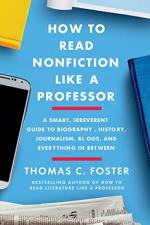
|
| Name: _________________________ | Period: ___________________ |
This quiz consists of 5 multiple choice and 5 short answer questions through Section 2: Chapter 5, "It May Just Be Me, But..." through Chapter 8, "Bringing the News".
Multiple Choice Questions
1. In Chapter 8, "Bringing the News," one of the main points that Foster wants to make about All the President's Men is what?
(a) All the President's Men is a work of nonfiction.
(b) Woodward and Bernstein faced serious obstacles in investigating the Watergate story.
(c) Woodward and Bernstein used too many anonymous sources.
(d) It is unusual for people to write about themselves in the third person.
2. In Chapter 1, "The Structure of Nonfiction Information," what does Foster say the first job of the writer is, on page one?
(a) To get the reader to page two.
(b) To create a personal bond with the reader.
(c) To tell the truth.
(d) To be clear and concise.
3. In Chapter 7, "All in How You Look at Things," what is the purpose of Foster's discussion of structure in Coming into the Country?
(a) To show that cause and effect structure can be used for narrative.
(b) To demonstrate the limits of chronological structure.
(c) To show how chronological structure can be adapted to a particular message.
(d) To demonstrate that theme is dependent on detail.
4. What definition of "lede" does Foster give In Chapter 2, "The Ecology of the Nonfiction Biosphere"?
(a) A news item that also contains opinion.
(b) A short introductory piece of writing by an author who is not the author of the longer piece that follows.
(c) A brief summary of or tease for the event described in an article.
(d) A counterclaim to the main argument.
5. According to "The Building Blocks of Arguments," what are the "grounds" of a argument?
(a) The backing of a rebuttal or qualification.
(b) Factual data and evidence.
(c) The conclusions that an argument is based on.
(d) Explanations of the relationship between facts and claims.
Short Answer Questions
1. In Chapter 7, "All in How You Look at Things," what does Foster say is the purpose of the academic five-paragraph essay?
2. According to "The Building Blocks of Arguments," what is the only form of nonfiction that is not argumentative?
3. In Chapter 7, "All in How You Look at Things," Foster says that which type of nonfiction is usually better off starting at the beginning chronologically?
4. Based on Chapter 2, "The Ecology of the Nonfiction Biosphere," how would Foster sum up the place of newspapers in today's world?
5. According to "The Building Blocks of Arguments," what is the implicit argument of most nonfiction writing?
|
This section contains 513 words (approx. 2 pages at 300 words per page) |

|




